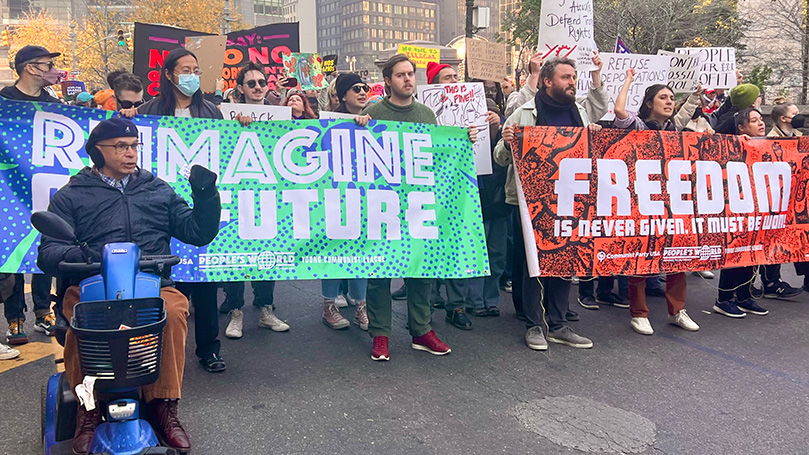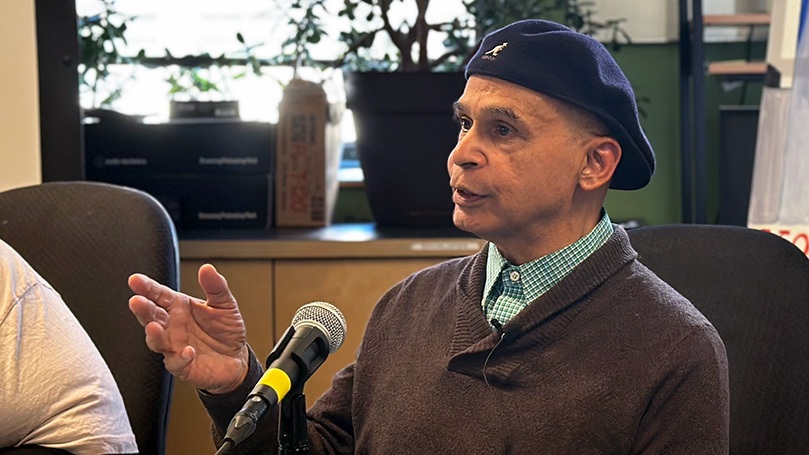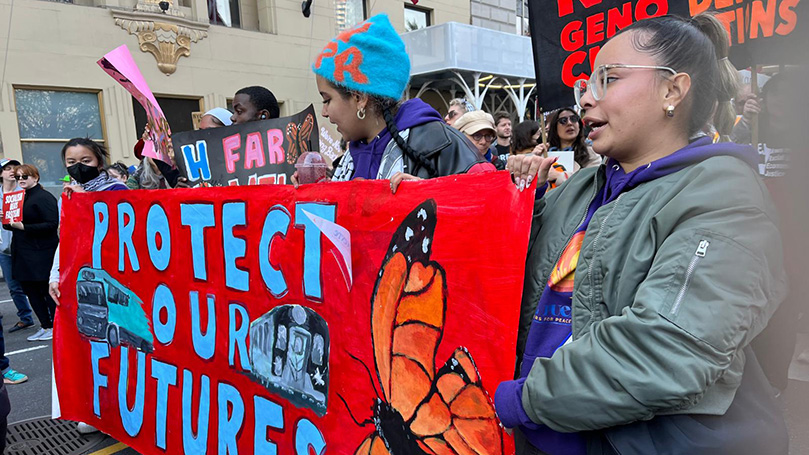
Main report given by Joe Sims to the CPUSA National Committee on Saturday, November 16.
Well comrades, the election results are in, and to put it mildly, it ain’t pretty. Trump won the battleground states, about 20 others, and the Electoral College. The GOP won the Senate and the House. It appears he’ll win the popular vote by about one and a half percent. That’s the picture so far, and while it’s a very challenging situation, it’s not the national realignment and move to the right that the talking heads have been crowing about for the last week. The ruling class may have moved to the right and the federal government will most definitely move right — but not a majority of our class and people.
One and a half percent is one and a half percent. As comrade Michael posted on my Facebook page the other day, “Trump won on the margins, or you could say Harris lost on the margins.” In either case, there’s no resounding mandate. There was no major repudiation of abortion rights, LGBTQ rights, civil rights, and other equality issues.
Woke ain’t broke, notwithstanding the fact that this was the most racist, sexist, and homophobic campaign in memory. There were, of course, issues that interpenetrated with this racism and sexism that affected the outcome: the Gaza genocide; the price of gas, eggs, and rent; the crisis at the border; student debt. And in these circumstances, the fact is a majority of those who cast their ballot did so for a Hitler-loving rapist and insurrectionist. And the fact is that despite these things being well known, the anti-MAGA majority did not show up in sufficient force on Election Day to change that outcome.
Today, the National Committee is tasked with thinking through how and why did that happen? And what are the consequences? The goal here is not to point fingers and take part in a blame game — a circular firing squad will help no one — but to objectively examine what happened.
This campaign occurred within the context of a deep systemic crisis of capitalism.
And before going further, we should never forget, as we said at the convention, that this campaign occurred within the context of a deep systemic crisis of capitalism. Let’s recall that our working class — citizen and non-citizen, Black, white, Latino, Asian, straight and LGBTQ, young and old — are hurting. Let’s remember that there is a profound environmental crisis, a gun crisis, an ongoing drug crisis, and a housing crisis, along with U.S. imperialism’s ongoing support of wars in Ukraine and Gaza. And let us remind ourselves that this is accompanied by a profound crisis of governance: that wide sections of the population have lost confidence in Congress, the presidency and the courts. We don’t trust the mass media, big business, religious institutions, or the two main political parties. Union popularity is up, though. Let’s remember that the number of independents now are larger than the combined total of both political parties. And the truth is that neither of the parties or their candidates addressed the real underlying causes to the conditions our class is facing, or proposed solutions.
Those are the objective circumstances that led up to what happened on Election Day. Let’s talk about that for a moment.
What happened?
First of all, it looks like Harris will bring in about 76 million votes. That’s more than Obama, Hillary Clinton, or Trump got in any previous election. In four of the seven swing states, Harris won more votes than Biden got last time, and ran even with him in the others. In Michigan and Georgia, she received more than Trump scored in 2020. It’s said Harris won more than any other Democratic candidate in Nevada, North Carolina, Georgia, and Wisconsin. As one writer said, that should have been enough to win in an ordinary election — but this election wasn’t ordinary. Notwithstanding Harris’ record numbers, Trump won more in Nevada, North Carolina, Georgia, and Wisconsin than any other candidate of either party, ever. Simply put, the democratic movement got out-organized.
How’d that happen? Well, in the first place, Trump and MAGA started organizing the day after they left office in 2020. They held rally after rally for four years, using them as organizing tools to fund raise, develop mailing lists, engage and mobilize their base. While there has been a well-organized and well-financed mass movement around Trump since 2016, there was no such momentum around the Biden campaign this time around. There was a movement in 2020 when Biden got 81 million votes. It wasn’t around Biden per se, but public reaction to Trump’s mismanagement of the pandemic, along with the impact of the uprisings against police violence and murder on the election. Back then, there was an organized movement from the streets to the ballot box.

A movement did develop, however, after Biden dropped out. It exploded around Harris and the prospect of electing the first African American woman president. And when you think about this election and you compare the two candidates, you’re comparing what Harris and Walz accomplished in 100 days with what it took Trump four years to build. In just three months, we’re talking about huge mass rallies both online and offline; we’re talking about the organization of what’s said to have been hundreds of thousands of volunteers; and last, but not least, the raising of over $1 billion. The anti-MAGA majority and its coalition flowered into a mass movement again. But it wasn’t enough.
Secondly, as we know, questions are being raised about the campaign’s strategy in relation to courting the never Trumper wing of the GOP and some independents. People are asking whether or not it would have been better to focus on turning out the sections of the coalition who failed to show up on Election Day, particularly in the blue states where turnout dropped. Those are legitimate issues.
We should participate in that conversation, keeping in mind what was at stake and the difficulty in balancing the needs of a multi-class coalition and the respective demands on it. The ruling class was the dominant force in the campaign. The working class and trade unions were unable to adequately place their imprint on the contest. It had an impact, no doubt, but it wasn’t what it could have or should have been. In that regard, the Harris–Walz ticket didn’t match the platform of the 2020 campaign. In fact, in some respects it marked a retreat from 2020, e.g., with regard to the death penalty. While it started off on a hopeful note with the selection of Tim Walz and the campaign’s opening at the UAW, it seemed to stall midstream. And its closing message on fascism, without it being accompanied by drilling down hard on the economic issues affecting working people and proposing remedies, may have been a miscalculation.
Now, don’t misunderstand: it was important to bring the fascism issue into the center of the campaign and it’s sure to pay off in the fight ahead. Still, it is legitimate to ask if it was conveyed effectively. Admittedly, it’s a difficult question. Recall that some in our own ranks had difficulty accepting the idea that fascism presented a serious threat. There was this “it-can’t-happen-here” notion, the idea that the U.S. is unique and different from other countries, not governed by the same rules or the same laws of motion. American Exceptionalism strikes again.
Another factor is that the U.S. doesn’t have recent experience with an anti-fascist-war being fought on our soil, as occurred in Europe and on other continents. Nor does a significant section of the country know what it’s like to live under dictatorial conditions. The exception to that are people of color — African Americans, Native Americans and Latinos, in particular. And so it’s likely that to many the fascism charge seemed at best a stretch, and at worst, name calling.
But a larger issue was the failure to adequately voice the depth of the frustration of both rural and urban working-class folk regarding their conditions of life, and to put forward a platform that would address those issues. Proposals around raising the minimum wage, the $6,000 tax credit, price gouging, Medicare for homecare, home ownership, and promoting small businesses, while important, did not address the scale of the crisis. And even that got muted as the campaign ended. And then some sections of the population weren’t reached by either party. This was true with respect to the Latino vote, where half polled said they hadn’t been contacted.
We should direct our fire at the ruling class and focus on how workers can make their influence felt on the democratic movement as a whole.
We should take note that in recent days the campaign has been critiqued by folks like Bernie Sanders and Robert Reich, both of whom place fault at the feet of the Democratic Party’s long-term failure to address working-class concerns and point a finger at the real cause of our distress. Clearly they have a point, although, regrettably, the complaints about “identity” politics are misguided. On the other hand, I don’t think our job is to critique the Democratic Party from outside in a way that may give the appearance we are formally part of that party. Of course, we should critique their policies as they adversely affect our class. Most important is that we should direct our fire at the ruling class as a whole and again focus on how to make it possible for workers to make their influence felt on the small-d democratic movement.
Those working within the Democratic Party face a difficult proposition as their leaders are loath to even mouth the word “working class,” middle class being their term of choice. The MAGA GOP on the other hand, have no problem demagogically calling themselves a working-class party.
And in these circumstances, Trump was able to run as a right-wing populist, a working-class billionaire, an outsider: anti-system, anti-swamp, anti-Establishment. And the Democrats failed to successfully challenge the rebellious political character Trump managed to construct for himself in the public imagination and point out that he himself was a creature of big capital; not an outsider, but a figure completely beholden to the military, oil and tech corporations.
Harris, on the other hand, ran from the center. And one can appreciate the argument for doing so. But the question is, can you run from the center against a guy like Trump, who is running against the system, without a strong thrust from the left? And if that’s the case, why did Harris hold the left at arms length as was widely perceived? Because she was red-baited? Well, so was Obama and Biden, for that matter.
In any event, these are speculative issues. The main question is where do we go from here? How are we going to respond to the most dangerous election outcome in this country’s recent history?
Where do we go from here?
In the first place, responding has to take into account the new balance of forces. In this regard, the anti-MAGA majority may have gotten side tracked on Election Day, but it has not disappeared. And it’s that coalition that remains the basis for the fight back. Fortunately, it’s already regrouping. Did you know that just 3 days after the election some 140,000 people representing 200 organizations gathered in an online mass meeting organized by the Working Families Party? It’s true. And just a few days later, over 10,000 joined a Win With Black Women online event also to strategize on how to go forward. And then, a few days later, 20,000 joined an Indivisible call with the same goal.
Some are planning a three-fold strategy in blue states of legislative action, legal action, and mass action. Others are putting together a plan to call on Biden to take executive action on a number of issues before Trump comes to power. The important thing is that the anti-MAGA forces are planning, strategizing, and fighting. That’s going to make all the difference in the world.
And we have to be part of this coalition effort. Coalitions, united front efforts, are a way of life for the Communist Party. And when we say coalitions and united fronts, we mean building unity of action on issues with anyone who agrees to work on the issue, without preconditions. You can be MAGA, or a Buddhist, or an animist or Catholic or a nationalist libertarian, so long as we agree to push ahead on the issue that brought us together. And we will discuss our differences as we go along.
I raise this issue because I hear some are questioning coalitions, claiming they don’t work. Or if they favor coalition work, it’s proposed that we bond with the sectarian left. But that would lead us down a narrow path precisely when we need to build ties and influence broad sections of the population, including those influenced by Trump — as we’ve said repeatedly, that’s where the action is.
Building the anti-MAGA coalition is going to be an uphill battle. The Trump forces have the presidency, the Senate, the House, and the Supreme Court, and one can bet they’re going to come out swinging on January 20th. Their obvious targets are going to be immigrants, environmental protection, and the Department of Education. And they’re going to attempt to do as much as they can as quickly as they can. The first 100 days will be the first test; then they’ll have four or five months before campaigning for the midterms begins.

The midterms will be hugely important because it’ll be the first opportunity to put a break on MAGA’s attempt to turn back the 20th Century — and that is not an overstatement. The GOP’s goal is to dismantle what they call the “administrative state,” that is, many of the programs established during the New Deal and the reforms of the Civil Rights era. In other words, their objective is to do away with government as we know it: this is what the new Department of Government Efficiency headed by Musk and Ramaswamy is all about.
So we’re in for a period of intense class and democratic struggle. It’s going to be heavy. We can expect that the GOP is going to use all of the means at their disposal, including threats, intimidation, and fear, to accomplish their goals. It’s already started with the racist text messages to African American students and others, along with misogynistic posts against women. After the election, neo-Nazis held marches in Columbus, Detroit, and elsewhere. In some parts of the country, leaflets are appearing in immigrant neighborhoods requesting undocumented workers be reported to local authorities. Children are being affected as well. In fact, a child of one of our comrades was racially harassed in grade school this week.
Notwithstanding these challenges, as we said in our initial statement after the election, we will get through this. We know that because in a certain sense we’ve been here before. It’s not the first time the far right has had control of all 3 branches of government. Trump had it in 2016 and tried to get rid of Obamacare, remember that? It failed. Before that in 2004, Bush was in the White House. The GOP controlled Congress and used that control to deregulate and attempt to privatize Social Security. Big mistake on both counts. Going after Social Security — the “third rail” of U.S. politics — caused the Republicans to lose control of Congress in the midterms. Deregulation helped spark the 2008 subprime loan crisis that nearly brought down the U.S. and world economy. Next thing you know, Barack Obama got elected.
However, we have to be careful when making comparisons. The GOP of today is not the one of yesterday. There’s definitely a more distinct fascist influence at work now and MAGA controls the levels of power in the RNC and many state organizations. But can it be said that they’re now a fascist party? Figures like Bush, Romney, Cheney, Bill Barr and others remain in the party. And remember what happened in 2020 with the GOP state organizations that resisted Trump’s attempt to overturn the election, among them Georgia, Pennsylvania, and Michigan.
In this regard, we have to pay attention to who Trump is appointing and what they represent. It’s already apparent that they’re prioritizing the most rightwing forces with Gaetz, Stephen Miller, Hegseth, and others. And Trump’s demand that the Senate allow recess appointments is a strong signal of the dictatorial manner in which he intends to rule. So get ready.
Build the party like never before
As events unfold, we have to strive to be part of the mainstream opposition coalitions and to build unity on the issues with the forces we influence. Our efforts to build and rebuild the party and consolidate the results of the convention, must be part of this process. We have an opportunity now to build the party like we haven’t had before. Do you know that since election day, some 300-plus new members have joined?
More and more, people want to hear what we have to say. It’s already apparent in our social media. Our “don’t lose hope” message has drawn 5 times the number of usual views. In the last few weeks, our Good Morning Revolution views on YouTube have doubled. It’s still modest, but growing. Our social media collectives have been doing great work on Instagram, X, and Facebook. And we have to congratulate the staff of People’s World who continue to do outstanding reporting and analysis.
Our party is continuing to grow and consolidate that growth. As members join, new clubs are coming into being in several states. Welcome to the Communist Party! District organizations are strengthening themselves and are in the process of electing new leaderships in many places, as well.
As you know, the convention mandated that we take steps to strengthen ourselves organizationally and we’re going to meet that demand with a proposal to elect a new Organization Secretary. Our Labor, Education, Political Action, African American, Women’s Collectives are reorganizing while continuing their important work.
Our YCL clubs under comrade Aaron’s leadership are growing in a number of places around the country. And we should take note of something new here, a maturation in the political and ideological outlook of our youth in the leadership of our clubs in DC, Philly, NY and other places that will help lay the basis for building a national organization and having a convention. The party and YCL are more united ideologically and with respect to our strategic line than we’ve been in many years. We support the YCL and the YCL supports the Party, and that’s a combination that can’t be beat.
So in closing comrades, we say again, we will get through this: like we got through the Palmer Raids, like we got through the Klan when we were organizing the South, like we got through the Cold War and Joe McCarthy, like we got through Reagan and Bush. Like we got through Trump 1.0 — and we will get through this second edition. Project 2025 is not inevitable. You cannot keep this good party, our YCL, and our working class down. Let the discussion begin!
Editor’s Note: This article has been edited for clarity.
Images: Party members at the Protect Our Futures march in NYC (CPUSA, NY District); Joe Sims delivering his remarks to the CPUSA National Committee (CPUSA); People march to protect our futures (CPUSA)


 Join Now
Join Now